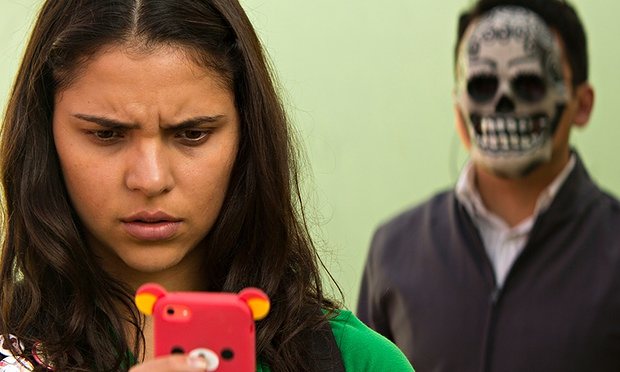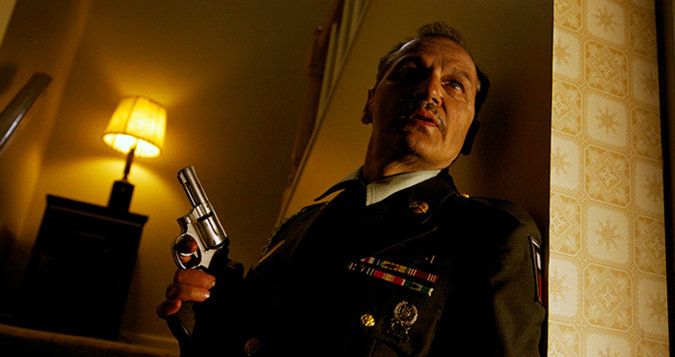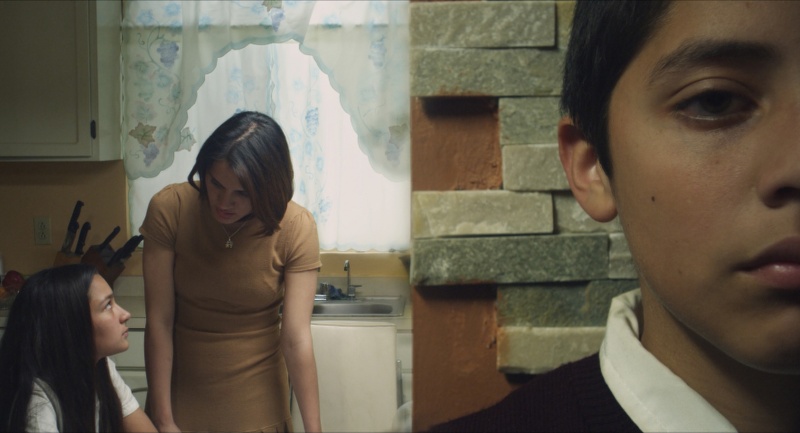
There’s a running joke that Adrián García Bogliano is heading north in the Americas, and every film gets him closer to Canada. The Spanish-born director had worked on multiple low-budget films in his adopted home of Argentina before his breakout festival success, 2010’s Cold Sweat. He followed that with the supernatural Penumbra, before heading to Mexico for Here Comes the Devil, and the US with werewolf thriller Late Phases. For his latest, rather than heading to the great white north, takes him back to Mexico, where Arran (Francisco Barreiro, Here Comes the Devil, We Are What We Are) kidnaps a teenage girl. However, his
(A version of this interview previously appeared at AustinChronicle.com)
Richard Whittaker: So far, you’ve directed films in Argentina, Costa Rico, Mexico, and the US. What’s the difference between working in those different countries?
Adrián García Bogliano: There are so, so many differences A lot of things in common, but I think that the biggest differences, industrywise, in terms of how actors approach tha metarila, in the United States I think the actors are a lot more used to working in cinema. So it’s easier for them to do movies, but at the same time I think that they risk less than Latin American actors do. I think that’s something that Francisco is very good at. He really risks a lot. You see that he;s putting a lot intyo everything that he does, and I think that American actors tend to be safe. Also, the difference in terms of how to make a horror movie there and here, is that I think that Americans are maybe a little too self-aware. Which is good in some things, because I think that they have a lot more perspective on the history of horror and where they are standing. Where the Latin Americans, we don’t have a lot of history of horror. Mexico is probably the country with a bigger tradition, but many of those horror films that were produced here are very difficult to see. So people are not really aware of the tradition of horror in Latin America, so you have to make the rules while you do the films. That gives you some freedom that, when you come from a very specific tradition, I think you don’t have.
RW I was talking to Paulo Biscaia Filho about his new film Virgin Cheerleaders in Chains, and as a Brazilian, he’s got Coffin Joe and that’s it. There isn’t the tradition, so while there are Brazilian horror directors coming through, they’re feeling their way.
AGB: Absolutely, absolutely. When we released Cold Sweat in Argentina, it was the first release for an Argentinian horror film in 50 years. It was scary to have to full that void.
RW: The American market puts a lot more emphasis on the supernatural, and that’s where the market is. It seems a lot more acceptable in Latin American and South American films to have the antagonist be a person. It’s a very American 70s feel, where the bad guy can just be a bad guy.

AGB: Unfortunately, I think that’s the reality of what producers and distributors think the market is. Everywhere, people are asking for more or less the same kind of movies over and over again. You actually see that when you look at it, even in Hollywood movies. It’s very clear to me even in the productions of Blumhouse, for example. The films that get wider distribution – you can name The Purge and stuff like that – but the films that get a wider distribution usually are the ones to do with Paranormal Activity and stuff like that. Those other films are the ones going straight to Netflix. That’s unfortunately a thing that’s going on everywhere. Here in Mexico there is this notion for distributors that, if you don’t have a ghost or you don’t have a Satanic element to it, you can’t release your movie in theaters. That’s what they want, and I think everywhere it’s pretty difficult to fight against that preconception.
That’s one of the reasons I why I decided make Scherzo, because I knew it was going to be a very small film, and it was not going to compete with the very big films, but I wanted to make something very personal, and something that you don’t get very often in horror.
RW: I was wondering about the decision to go with a kidnap plot, knowing that it’s a very hot button topic that has become a major aspect of organized crime in some Latin American countries.
AGB: I like the idea of playing against expectations. I tried to do something like that in Here Comes the Devil. We went to shoot the movie in Tijuana, and everyone was reluctant to work with is because they thought we were going to make something about the drug cartels. We were like, no, no, no, this is nothing to do with that. It’s a very brutal film, but it has nothing to do with the aspects you normally see in Tijuana. Everyone was really happy to help us, because we were showing a very different aspect. I think when you set up a movie like Here Comes the Devil and say, there are these two little kids that are going to get lost Tijuana, you’re going to think a lot of different things – prostitution rings, or drug cartels, or stuff like that. You find that the movie has nothing to do with that. I think that was an interesting choice, because you don’t have to do anything on the movie to suggest that, and just what the people know about the place is going to play in that direction. It’s pretty awesome.
If you say ‘kidnapping’ and you say ‘Mexico City,’ you’re going to think of certain things that are nothing to do with the movie. It triggers another level of thinking with the audience, which is pretty cool. That was the idea all the time, doing something that has all the background and all the flavors. You can definitely look at it and know that it’s Mexico, but it’s definitely not the typical thing that you would see happening here. That’s the way I feel about this country. It’s got a lot of awful press, but there are so many other things happening here, good and bad, other than the things that are in the newspapers every day. It’s an interesting thing to find these other aspects of the culture that work against expectations.
RW: That’s a part of the story, that Francisco’s character thinks, ‘Ah-hah, everyone will think it’s organized criminals doing the kidnapping, but it’s really me.’ He’s this total worthless little guy who thinks that, rather than asking for a raise, goes through this ridiculously elaborate scheme. So how did you come up with that central character?
AGB: It’s almost a fantasy that goes completely wrong. This fantasy of getting everything that you really want, and having the woman and having the mistress and having the best job. It’s a very miserable fantasy, but it’s a very common fantasy. But I thought that there were elements that, well, the person that he kidnaps is a school age girl and is dressed in a high school uniform. At the beginning, you wonder if he’s a pervert, and then you realize that he’s not really going for that. But then you see him looking at the pictures of naked women, and finally the picture of the naked teenager. So if you think it’s about that, then you realize it was about that, but then it kind of was about that. Changing like that, I think was an interesting thing.

RW: Did you always have Francisco in mind? Because in Here comes the Devil, he’s a guy totally out of control of his surroundings and in constant panic, and here he’s often the polar opposite.
AGB: Absolutely. I wrote the movie for him. From day one, he was around. I think that one of the reasons was because of that. I saw him first in We Are What We Are, and you realize that he’s a guy that can do so many thing, that I wanted to take advantage of that. What I showed of him in Here Comes the Devil was a very small part of that. I don’t say that because he’s in my movie. He’s in my movie because I really think he’s the best actor of his generation here in Mexico. I’ve worked with several great actors in my movies, but he is the guy who has probably the biggest range, and do the most different kind of things.
RW: You’ve had a progression in your films where you went a little bigger, and a little bigger, and a little bigger, and this was such a smaller team for Scherzo. What was it like, going back to something so much close to your roots after Late Phases, which had complicate suits and a bigger cast?
AGB: I felt really comfortable, because the script was written for that. It wasn’t a case where you write something and have to make it smaller. This is something that I wrote for the landscapes that I knew, the places that I knew I could find, the actors – some of them, at least – that I thought that I could get. A lot of this I had in mind beforehand, so it was pretty easy. And I have to say, it was the first time I have worked with such a small team. I’ve made movies in Argentina for very little budget, but always with bigger crews – 20, 30 people, at the very least. This was an experience that I wanted to have, going through shooting in a very intimate way, and being very close to the actors, and not having a bunch of people moving around. Just having a chance to be close to the actors and have them concentrate. Not being on set, asking for silence from 50 people.
It was really cool, because this is something I couldn’t have done 10 years ago. It’s to do with the technology that we have at hand. Even though it’s an independent film, and it looks like an independent film, it looks like a lot bigger than what you could see while we were shooting the movie. It’s got the right scope for the story and for what we wanted. It would have been impossible to make it look as good as it looks 10 years ago.
RW: It’s also meant the entry point for films is getting lower, because it’s never been easier to make a film. At the same time, the technology means there are fewer excuses for something looking bad. I’ve had that conversation about special effects in big budget movies: at this point, they better look good. It’s a matter of how good a story you can tell.
AGB: Absolutely. Of course I understand the filmmakers who are doing those kind of blue prints for them to be seen by Hollywood and taken to Hollywood, but that’s not what I’m looking for. To me it’s interesting that I got a lot more attention from bigger production companies, and people from Hollywood, from very small movies than I did from my bigger movies. I don’t think, at the end of the day, those people are looking for great effects, or little movies that look like $100 million movies. They’re looking for people with voices, with talent, and I think that that’s what you should be doing as a director – showing your voice, not the tools that you have. Because someone’s going to have better tools than you, always.
RW: So what are you working on next and, more importantly, where?
AGB: I’m preparing something. We still can’t announce it, but it’s going to be something pretty different, and I can tell you it’s going to be in another country where I have never made anything before. A very demented supernatural thing, that’s what I know for sure.